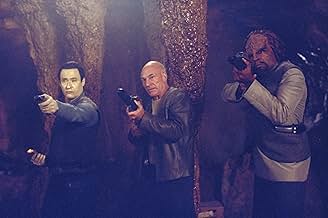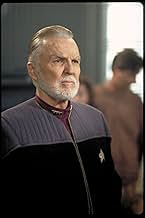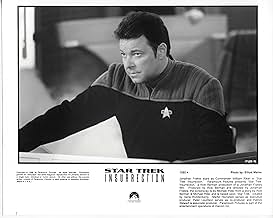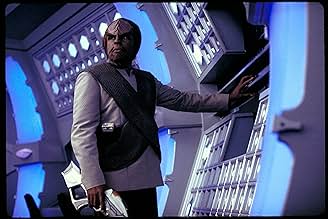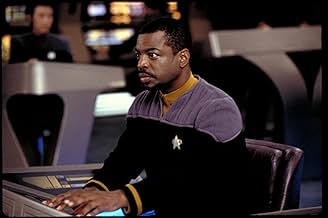Lorsque l'équipage de l'Enterprise apprend qu'il existe une conspiration de la Fédération contre les habitants d'une planète unique, le capitaine Picard commence une rébellion.Lorsque l'équipage de l'Enterprise apprend qu'il existe une conspiration de la Fédération contre les habitants d'une planète unique, le capitaine Picard commence une rébellion.Lorsque l'équipage de l'Enterprise apprend qu'il existe une conspiration de la Fédération contre les habitants d'une planète unique, le capitaine Picard commence une rébellion.
- Réalisation
- Scénario
- Casting principal
- Récompenses
- 3 victoires et 8 nominations au total
- Geordi
- (as Levar Burton)
Avis à la une
The above exchange occurs during Insurrection's key scene. The entire first half of the film meticulously builds to this conversation between Starfleet officers. Dougherty (Anthony Derbe) justified his actions because the needs of the many outweigh the needs of the few. Picard (Patrick Stewart) sights the Prime Directive, which prohibits interference with other cultures or their natural development. The two officers had remained on a collision course until the moment when something had to give.
The conflict begins during a routine survey. Insurrection opens with a gorgeous panorama of an agrarian village. Children frolic about in the tall grass outside the perimeter. Farmers lift gates to aqueducts, women laugh pleasantly as they slam down their bread dough for kneading and the blacksmith works away. We are treated to long panoramic looks at the restful town and its benign inhabitants, the Ba'ku. Members of a culture survey walk about unnoticed in their isolation suits, invisible to the eye. Director Jonathan Frakes' willingness to take so much time introducing the audience to the setting demonstrates an unusual amount of focus for a movie like this.
The peace is shattered when Data (Brent Spiner) begins acting wildly. He exposes the survey and follows with many more bizarre and aggressive actions. The architects of survey, Admiral Dougherty and the So'na leader Ad'har Ru'afo (F. Murray Abraham) orbit above the planet. Data's behavior puzzles and scares them, and they ask Picard how to destroy him.
Delaying his orders, Picard (Patrick Stewart) arrives and successfully captures Data. Against the wishes of Dougherty, Picard stays to determine why his android became a loose cannon. Picard acquaints himself with Anij (Donna Murphy), a Ba'ku woman who informs him that Data told the Ba'ku that the survey team was their enemy. A short investigation uncovers a conspiracy to forcibly remove the Ba'ku from their planet.
The planet, buried deep in a gaseous cloud called the Briar Patch, has rings that act as a fountain of youth to its inhabitants. Dougherty and Ru'afo believe that the planet must be used for medical reasons, and Picard is forced to make the choice to abandon the Ba'ku or violate his orders.
It is at this point when the film accelerates. The conflict becomes a proverbial chess match between grand masters as the Enterprise crew tries to keep the planet inhabited. Both sides devise as many solutions as they can think of to accomplish their missions. The audience is almost invited to participate as the movie keeps them wondering what the next move will be.
The script shines with an abnormal level of polish. It deftly handles the question of whether an officer should obey orders or stand up for what is right. Almost every line flawlessly captures the writers' intent and communicates them to the viewers with beautiful yet easily understood diction. Every character sounds expressive and well educated. The dialogue is free-flowing and enjoyable. There is even a scene where Picard calms Data with a rousing rendition of "A British Tar." I imagine the production staff had a good laugh when they thought of that one.
The acting is of the highest Trek standards. Abraham, one of the true gentlemen in Hollywood, is exceptionally good as Ru'afo. He is so superior that he has every subtlety mastered. The way his face sneers when he says "Eliminate them," his vocal inflections, his different postures, his mannerisms, the passion and disdain in his voice all point to the work of a true master. Hatred seems to perspire from his every pore. A blood vessel bursts in his face and we can almost see hate flowing out of it. His friend Gellatin (Gregg Henry) is constantly talking him out of more extreme decisions. For Ru'afo, it is personal, but we do not find out why until the final act. He tops it all off with the best scream of anguish and frustration ever captured on film. Ru'afo may not quite be the most effective Star Trek villain, but Abraham's acting is the best in the series. He is not the most prolific actor, but he is arguably one of the best ever.
Sadly, some of the story devices fall flat. In First Contact, the Enterprise was the most advanced starship ever made. Its quantum torpedoes were so powerful that it seemed nigh invincible. Here, however, it is too weak. There is one exchange where it is fighting with two So'na ships and seems badly overmatched. The Enterprise-E was designed to take on small fleets and win. If the Federation could defeat "the Borg, the Cardassians, the Dominion," why can't the crown jewel of its fleet defeat two So'na cruisers? It is even controlled at one point by simple joystick. I never knew flying a 700-meter starcraft was so simple. Redemption does come with the ingenious denouement of the fight. There are also other moments that do not work, and some jokes fall flat.
In the end, Insurrection shoots itself in the foot. It also suffers from following First Contact and the Borg. It is an entirely different production with different goals. It may hurt itself, but in the end it is solid enough entertainment to rate a seven out of ten.
The conflict of this film works on two levels: First, there is the conflict between two races of people (a plot point as old as time but one that, if done right, can be quite effective). Second, there is the conflict between Captain Jean-Luc Picard (and thus his crew) against upper-ranking Federation officials, who want to violate the sacred Prime Directive of the universe. Both of those areas of conflict, acting simultaneously throughout the movie, are surprisingly effective and compelling.
Besides the effectiveness of the main plot, however, this film also (much like the previous First Contact film) contains some interesting and humorous character development. While trying to rescue a persecuted race of people, the crew of the Enterprise investigates a planet on which the effects of aging are reversed. Thus, while the android Data is unaffected, other characters are taken on an interesting hormonal journey: Worf begins acting like a typical (violent!) Klingon youth, Crusher and Troi notice certain, um, body parts firming up, and Geordi LaForge regains the use of his natural eyes.
To conclude, Star Trek: Insurrection, while generally regarded as a sub-par effort, actually breaks the "odd-bad, even-good" chain of Star Trek movies. If you are new to the Star Trek universe and are interested in this movie, I would recommend watching the previous film, First Contact, in order to get a better handle on the Next Generation characters before watching this film. If you thoroughly enjoyed First Contact, this movie (with its action/adventure combined with great human drama and humor) will not disappoint you.
I may be in the minority when it comes to this movie, but I think it is important to defend this great Star Trek movie, especially since the really bad Nemisis came out. We have to judge this movies on it's own merits and on the idea of what Star Trek is all about.
While it is 100% fact that the odd numbered Star Trek films are not as good as the even numbers, this film will not help to dispel the theory. While not the worst Star Trek film, it does have plenty of problems that stops it being better than it should be. The main weakness is the plot which, at the start, is morally difficult. I mean why wouldn't it make sense to move the Ba'ku and allow them to share the power of the planet with many millions of others and not just keep 500 alive forever? This is nicely forgotten when the film decides it needs a bad guy and gives things over to the Son'a a good move in terms of creating a more action packed climax but a poor move in terms of plot logic. The action is so-so allowing for battles in space and on the planet, but it is not as dramatic as I hoped with the planet based stuff taking away from the film and not being as dramatic as it could have been.
The script does allow some witty moments but too often the dialogue is a bit ponderous, and there are no great lines or really memorable spells of dialogue or interaction. The romance between Picard and Anij is a bit of a distraction, as is the stuff between Riker and Troy points of the film feel a bit more like a space soap/romance rather than sci-fi as I think of it.
The cast are average. Most have the odd good line or scene but really the majority of the group do not have much to do. Stewart has the lion's share of the film, despite the romance slowing things down. Frakes has some good scenes but is a far second, seeming happy to direct. Abraham does an OK baddie and the rest of the Enterprise cast basically do what they are accustom to doing weekly and they don't really rise to the film occasion.
Overall this is an average film and keeps the trend of `even good, odd not so good' Star Trek films going nicely. The holes in the plot are a bit of a pain no matter how hard I tried to ignore them it would have been nice if the debate hadn't been side tracked by a more traditional plot.
Le saviez-vous
- AnecdotesIn the scene where Captain Picard and the Admiral are in Picard's ready room, there is a cloth on the back of Picard's chair. This is the cloth given to him by the Mintakans in Who Watches the Watchers (1989), an episode in which Starfleet used a duck blind for anthropological purposes.
- GaffesTroi comments that she had never kissed Riker with a beard before. Yet Troi had kissed the bearded Riker in Ménage à Troi (1990), as well as in several other occasions on Star Trek: La nouvelle génération (1987).
- Citations
Admiral Matthew Dougherty: Jean-Luc, we're only moving 600 people.
Captain Picard: How many people does it take, Admiral, before it becomes wrong? Hmm? A thousand, fifty thousand, a million? How many people does it take, Admiral?
- Versions alternativesThe original version of the movie contained several scenes that were cut before release:
- an extended library scene in which Riker and Troi throw small paperballs at each other. This scene also include some lines by the Librarian (Lee Arone-Biggs) and a Trill Officer (Max Grodénchik);
- a scene in which Picard and Anij kiss each other;
- a scene in which Picard spills cheese on a PADD displaying the Briar Patch;
- the actual ejection of the warp core;
- Data punching some Son'as on the planet and nailing them with iso-linear tags;
- "There will be no cover-up!" line on the Son'a ship.
- Bandes originalesTheme from Star Trek: The Motion Picture
by Jerry Goldsmith
Meilleurs choix
- How long is Star Trek: Insurrection?Alimenté par Alexa
- What is 'Insurrection' about?
- Who returns from the previous movie?
- What does "insurrection" mean?
Détails
- Date de sortie
- Pays d’origine
- Site officiel
- Langue
- Aussi connu sous le nom de
- Viaje a las estrellas: Insurrección
- Lieux de tournage
- Convict Lake, Californie, États-Unis(Data enters the lake)
- Société de production
- Voir plus de crédits d'entreprise sur IMDbPro
Box-office
- Budget
- 58 000 000 $US (estimé)
- Montant brut aux États-Unis et au Canada
- 70 187 658 $US
- Week-end de sortie aux États-Unis et au Canada
- 22 052 836 $US
- 13 déc. 1998
- Montant brut mondial
- 112 587 658 $US
- Durée1 heure 43 minutes
- Couleur
- Mixage
- Rapport de forme
- 2.39 : 1
Contribuer à cette page




